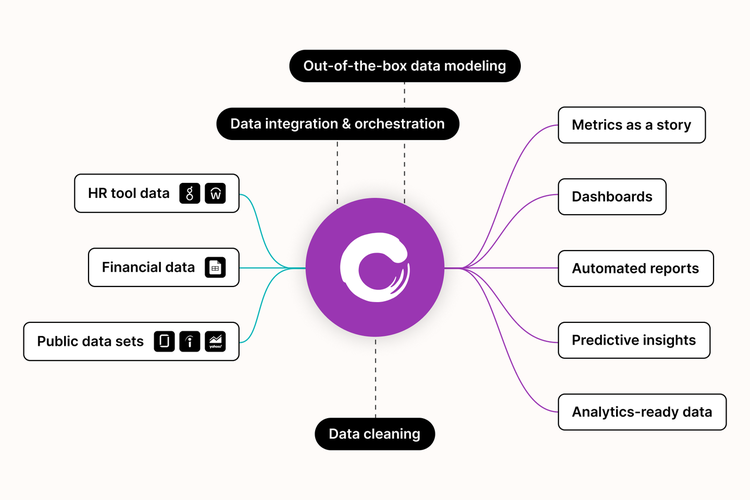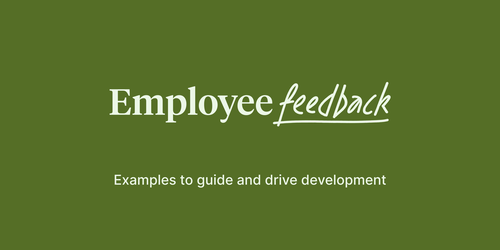
Article
Your people are your organization’s biggest asset, so you try to be as strategic and intentional as possible when making decisions that affect them.
But despite those best intentions, most organizations take a backwards approach to decision-making. According to a recent study from Oracle, an alarming 78% of business leaders say people in their organization often make decisions and then look for the data to justify them.
While there’s certainly room for a little bit of intuition in decision-making, your organization’s people are too important to rely on gut feel alone. Data should inform and influence your decisions rather than be used as supporting evidence for the choices you’ve already made.
That’s where people analytics comes in. People analytics extracts insights from large amounts of data about your workforce, so you can balance facts with feelings and make better decisions that benefit your entire organization.
This guide covers what you need to know about people analytics – what it is, why it matters, when to use it, and how to make the most of what you learn. Keep reading to learn how to take the leap from instincts to data-backed insights.
People analytics – often called workforce analytics, talent analytics, or HR analytics – refers to collecting and analyzing large amounts of people data (this can include information about job candidates, current employees, and the entire employee lifecycle) to provide actionable insights that support the organizational strategy and improve the business.
That sounds straightforward enough, but there’s a lot under the surface. Most people analytics tools will handle every aspect of your people data, including:
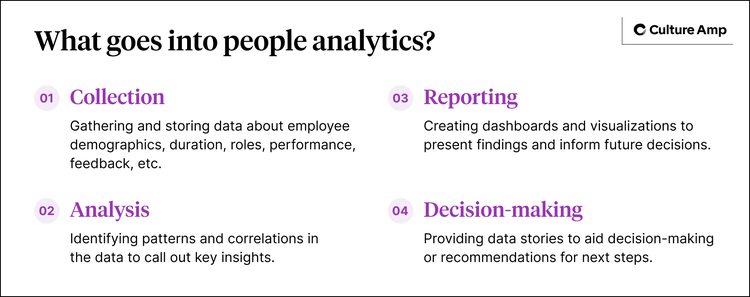
Imagine that your organization is experiencing high employee turnover. At that point, you turn to your people analytics software to review reports and pull out conclusions. For example, you might see that turnover is high among employees in a specific department or among those who have spent less than two years with the company.
That information helps you and your team know where to focus so you can dig deeper into the data and come up with targeted, data-backed solutions that can address your retention problems, such as:
And while the insights surfaced from people analytics platforms are powerful, they’re most meaningful when they’re combined with people science to develop a deeper understanding of what helps people thrive within your organization.
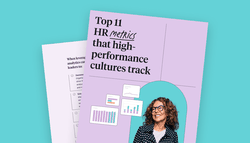
By focusing on these top 11 HR metrics across the employee lifecycle, you can fine-tune your HR strategy and people analytics practices to gain a more complete picture of the employee experience.
But it’s not all about putting out fires. From historical analysis to identifying problems before they happen, there are five different types of people analytics:
You can use people analytics to look at your workforce as a whole, as well as to zoom in on specific trends or topics – such as diversity, engagement, retention, or skills.
People analytics offers insights from a huge swath of data – and that means tapping into a varied assortment of data sources.
Your people analytics platform should look at everything from your company's financial data to employee survey results to performance management metrics (and more) to emphasize totality over tunnel vision. That’s how you’ll draw the most meaningful conclusions.
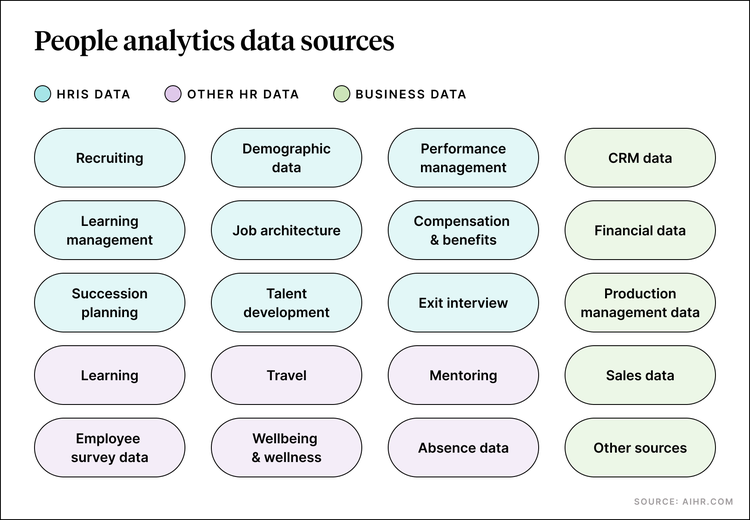
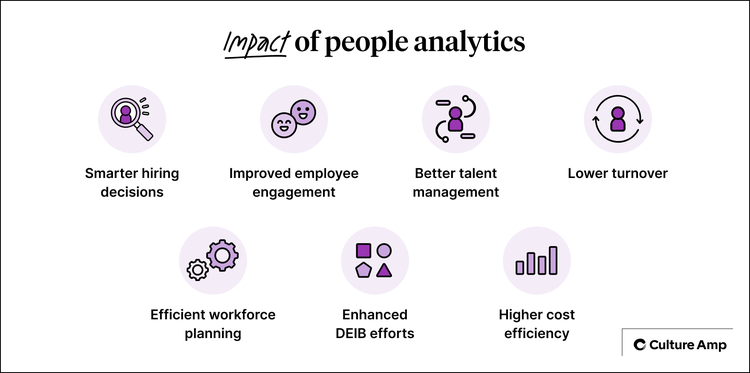
Why do your HR analytics matter? Here’s the simplest answer: this information fuels a data-driven culture and empowers organizations to make better and more informed decisions. Those better decisions have a ripple effect, leading to positive impacts across the entire organization, including:
With all of those potential benefits, it makes sense that 57% of HR professionals strongly agree that people analytics leads to improved business outcomes.

Join analyst Stacia Garr and Culture Amp’s Chief People Officer Justin Angsuwat on their journey to rethink, redefine, and revolutionize the role of people analytics in HR, rooted in industry insights and the CPO perspective.
It’s easy to think that people analytics are only important for your company’s HR team – the people steering the ship with regard to employee programs and initiatives.
However, when you think about your entire employee experience, managers are a crucial piece of the puzzle. They're the ones interacting with employees day in and day out, and they need access to accurate data to make informed decisions about their teams.
Yet, 77% of leaders say that the dashboards and charts they get access to do not always relate directly to the decisions they need to make on behalf of their teams. So, it’s not enough to simply give managers visibility into your people analytics. The information they receive needs to be relevant and actionable so they can make effective decisions that improve their team and, in turn, improve the entire organization.
People analytics is a growing field, with people analytics jobs on the rise over the past couple of years. According to a recent report from LinkedIn, “human resources analytics manager” was the second fastest growing job in the U.S., coming in only behind “head of revenue operations.”
But beyond the field itself steadily gaining steam, there’s another major milestone among the many key people analytics trends: the integration of AI and machine learning.
According to a report by the HR Research Institute, the top areas where organizations are using AI for people analytics are:
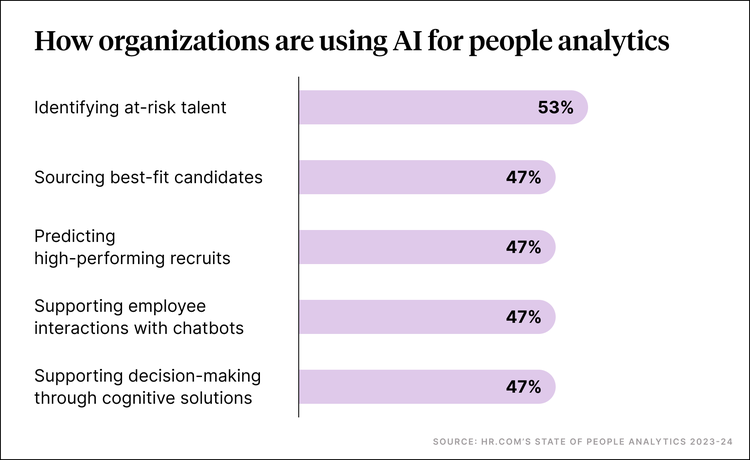
An impressive 58% of HR professionals believe AI will transform analytics and data management at their organizations. While most people are optimistic, there are still some concerns – particularly related to lack of visibility into how AI makes decisions (known as the “black box” problem). Only 3% of HR executives whose organizations use people analytics say their companies are well prepared to deal with this potential lack of transparency.
Concerns aside, AI adoption in HR continues to increase not only for automating routine tasks but also for supporting faster and better decision-making through cognitive analytics.
This allows HR professionals to pose a question in natural language and receive an instant answer synthesized from a huge people analytics data set. As Deloitte explains, “Cognitive technologies have been around for years; what’s new is the advancement in processing power that makes applying these technologies more feasible for quickly answering complex questions.”
People analytics will surface insights from a wealth of talent data. But while those numbers are important, they often need more context and a deeper understanding to inspire meaningful organizational change.
That’s why people analytics also needs people science. People science is a close examination of how people in your organization think, feel, behave, learn, and connect. Integrating people science with your people data gives HR professionals and business leaders a more holistic view of what’s happening within your organization to add nuance to the numbers.
Culture Amp’s people analytics platform is grounded in people science. It embeds people science into the platform’s back-end analysis, user experience, insights, and recommendations so you can make decisions that are rooted in data but also acknowledge and consider the complexity of the modern workplace.
Surveys are a powerful tool for gathering employee feedback at scale. However, it’s what you do with that survey data that holds the most weight with your employees and ultimately, drives better business outcomes.
Finding the right survey insights to act on takes focused effort. Because surveys are cyclical and only capture a moment in time, the sentiment from engagement surveys may not paint the full picture of what’s working and not working in your business. For a broader perspective, some companies export their raw engagement data to analyze alongside other employee lifecycle datasets, but this may raise privacy issues. Exporting survey data comes with a risk of violating confidentiality thresholds or skewing results when surveys are not completely anonymous.
To protect employee privacy, Culture Amp weaves engagement data from Engage into our platform-wide people analytics, enabling deeper, more sophisticated analysis of engagement and continuous listening that helps leaders understand the entire employee lifecycle on an ongoing basis, rather than seeing updates once a year.
Continuously pulling in data about employee engagement and performance gives businesses access to the most relevant and timely insights on retention, hiring quality, onboarding, performance, and rewards. This empowers more informed decision-making that leads to better strategic outcomes.
And because this data lives in Culture Amp throughout the process, you have full access to people analytics without the risk of raw exports ending up in the wrong hands. Culture Amp keeps your data safer with out-of-the-box metrics and people science insights embedded right in the platform.
For organizations interested in leveraging the power of people analytics, having people analytics software in place is the first step.
But when only 22% of HR professionals say their organizations are very or extremely effective at designing and implementing processes to get the most value out of people analytics, that’s only the beginning. Here are five strategies to not just collect the data but use it for maximum impact.
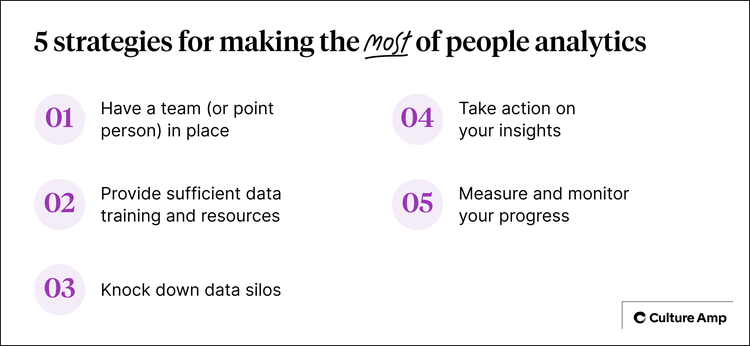
There’s a reason that people analytics jobs are increasing: you need people who are equipped to analyze, understand, and act on the data.
According to the same report by the HR Research Institute, organizations that excel at people analytics are two times more likely to have a designated head of people analytics compared to organizations that don’t excel.
Without somebody to take ownership over the collection, analysis, and reporting, your people analytics are merely intermittent insights – when they should be the foundation of all of your people-related decisions.
It’s not enough to give people access to the data – you also need to give them the training they need to comprehend it. Among organizations that use people analytics, 58% of HR executives admit that their company has insufficient resources to educate and upskill HR professionals on data literacy.
Ideally, that coaching and preparation should extend outside your HR team to any managers and supervisors who can benefit from people data. Data literacy is a key piece of leadership development. And the better equipped your managers are to understand the data, the more they’re able to make strategic decisions that improve your organization.
Culture Amp’s People Analytics tailors insights to each stakeholder’s needs, so they can see the difference-making data they need – without being overwhelmed by the rest.
You might think that the biggest people analytics challenge organizations face is that they don’t have enough of it. But, in most cases, the opposite problem is true: they have too much of it – and, even worse, it’s often fragmented or isolated from other important information:
One of the best ways to get a holistic view of your organization? Look for people analytics tools that integrate with your existing tech stack rather than disrupt your workflows. For example, Culture Amp’s seamless integrations and partner ecosystem help you keep people insights within arm’s reach – rather than relegated to a dashboard that’s checked once per year.
The other most challenging people analytics processes hinge on one word: action. Behind connecting different data sets, HR leaders say they struggle most with:
Data is only information. To see meaningful benefits within your organization, you need to take action on what you learn. Many people analytics software options (including Culture Amp) offer predictive insights and analytics to aid your decision making. For example, if you’re not on track to meet your hiring target, the software might recommend adding recruiters to your team.
Ultimately, people analytics should do more than provide you with insights – that information should trigger action.
People analytics is helpful for spotting problem areas, such as low retention or pay disparity. However, it’s equally as helpful for monitoring the solutions you implement.
Did you institute a new onboarding process to reduce turnover within the first year? Keep an eye on your numbers to see if that initiative makes a meaningful difference over the next six months to a year.
Doing so will help you determine if your efforts are working or if you need to change course. After all, when you’re using people analytics to improve your organization, you’re never done – it’s a constant work in progress.

Your people are involved in every function of your company, which means your people analytics will touch every function too. With that said, in the HR Research Institute report, HR leaders highlight the five most common areas where people analytics play an important role.
Improving or maintaining employee engagement is an ongoing struggle for employers, with only 33% of employees engaged in their work in 2023.
By analyzing data from employee surveys, performance reviews, and social interactions, companies can get a better read on the factors that affect workers’ job satisfaction and well-being and take action to increase their motivation, enthusiasm, and commitment.
Employee retention is the other most common use case. Organizations can analyze turnover data and feedback from exit interviews to identify the factors that cause employees to leave.
Those insights can help them develop retention strategies that more accurately satisfy employee needs.
DEIB efforts remain a top focus for employers, yet many workers say their employers’ efforts fall short of their expectations. This is another area where people analytics can help.
HR professionals and business leaders can review demographic data, employee survey responses, and hiring and promotion patterns to identify (and fix) potential disparities in representation, compensation, and career advancement opportunities.
Despite the fact that we’re turning to more of an employer-driven market, attracting top talent is still a key challenge for organizations. Fortunately, it’s also one of the most common people analytics use cases.
Companies can turn to data to identify workforce skill gaps and growth needs, understand traits of successful hires, determine attractive benefits to highlight, and more.
Employees are hungry for development and, according to our own data, the most important engagement factor for high performers is the performance management process itself.
Organizations can review data from performance evaluations, key performance indicators, productivity metrics, and skills assessments to identify top performers, spot areas for improvement, and tailor talent management or career development programs accordingly.
While the above use cases are some of the most common, they’re certainly not the only ways people analytics can be used in your organization. From managing major changes to analyzing your compensation and benefits, there are plenty of other areas where data can help you go beyond guesswork and make smarter, more beneficial decisions.
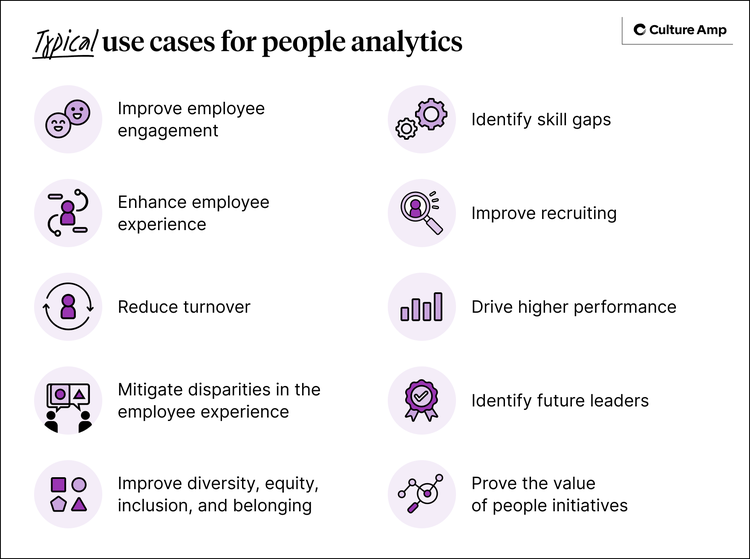
Employee performance is personal. The needs or goals of one employee are likely different from the next – which goes a long way in explaining why HR analytics tools are so helpful for improving and managing employee performance.
But, let’s dig a little deeper into the why and how of people analytics for performance management.
Without data, performance management can quickly become subjective and prone to bias. In contrast, people analytics forces managers, leaders, and HR professionals to look at workforce behavior, performance trends, and improvement areas with a data-focused lens.
Data can help highlight patterns that would otherwise go unnoticed as well as any discrepancies in performance based on department, tenure, or specific roles. All of that nitty-gritty information helps you identify and implement strategies that will truly support employee (and organizational) performance.
Employee performance reviews are also ripe for bias, but the right HR systems and people analytics tools can ensure these evaluations are as balanced and beneficial as possible.
People analytics benefits your performance reviews by:
All of those allow for performance and development conversations that are personalized, supportive, and data-backed.
You don’t just want HR data – you want data that does something for your organization. Here’s a look at how a few real-world brands are using HR metrics to improve two meaningful areas: employee engagement and workforce productivity.
Nasdaq uses workforce analytics to understand the drivers of some of its key people metrics – including employee engagement and performance management.
With these deeper insights and predictive analytics, the company is better able to anticipate challenges and implement solutions that address those specific issues.
And, as an added bonus, HR data helps them make a strong case to leadership. “We talked a lot about really optimizing our programs and processes to help influence those outcomes, so now we’ll have really strong numbers behind it,” explains Nicole Lettich, Director of People Analytics at Nasdaq.
The insights you get from HR analytics tools can also help your organization foster a more high-performance culture – much like Taboola did with Culture Amp.
Taboola uses Culture Amp to gather employee feedback and measure and manage employee performance. Using the HR metrics the company surfaced with Culture Amp, Taboola overhauled its performance management process to emphasize regular feedback and goal-setting.
While career growth was an area where Taboola previously struggled, acting on data allowed them to improve their approach to performance management and, as a result, workforce productivity. The result? The company generated a 5% increase in the number of employees who agreed that Taboola is a company where they can grow and develop.
From shaking a magic 8 ball to flipping a coin, there are plenty of ways to make decisions that rely on nothing more than a hunch or a little bit of luck. But decisions that affect your organization’s people are far too important to leave them to chance.
That’s why people analytics are so valuable. Whether you’re developing hiring plans, addressing retention or performance problems, improving company culture, or anything in between, people analytics give you the insights you need to make informed, data-backed decisions rather than relying on assumptions or anecdotal evidence.
If you want leaders across your company to access, analyze, and act on the data, they need to have an easy time doing so. With Culture Amp’s People Analytics, HR and business leaders can collect, unify, and organize their data in a single platform. Culture Amp’s compelling visualizations and data stories transform your organizational data into actionable intelligence so you can make smarter decisions that positively impact your people – and your entire organization.Your people are your organization’s biggest asset, so you try to be as strategic and intentional as possible when making decisions that affect them.
